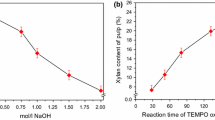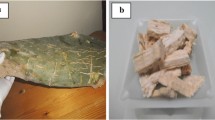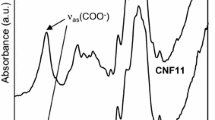Abstract
The effects of enzymatic treatments of dissolved and colloidalsubstances (DCS) released from thermomechanical pulp (TMP) have beeninvestigated. A model dispersion of DCS was made by leaching several portionsofTMP in distilled water and separating the fibrous material. Some samples wereenriched in colloidal particles by removing dissolved substances usingultra-filtration. The DCS, which had been subjected to different enzymatictreatments, were added in a fixed quantity to TMP fines that had been madecationic, and were subsequently used to form handsheets. All DCS additionsincreased the content of lipophilic extractives in the sheets. Lipase gave acomplete hydrolysation of triglycerides into free fatty acids. The untreatedDCSgave no significant decrease in tensile strength, because of the relativelysmall addition. A treatment of the DCS with Lipase gave a higher extractivescontent and a tensile strength on the same level as the reference. A Mannanasetreatment gave a decrease in strength compared with the reference at the sameamount of extractives in the sheet. A combined treatment with Mannanase andLipase gave a more pronounced decrease in tensile strength. Two possiblereasonsfor the differences in strength at a given amount of extractives weresuggested:(i) the destabilisation of the colloidal wood extractivesdue to the Mannanase could affect the distribution of the colloid in the sheet,making it more detrimental to sheet strength compared with the stable colloid.This would account for the observation that Lipase did not affect sheetstrengthas such, but the combination with Mannanase gave the lowest tensilestrength; (ii) the decomposition of galactoglucomannans in aqueoussolution would diminish their positive effect on tensile strength and/or affectthe adsorption of the colloid. A reflectometry technique was used to quantifythe adsorption of the differently treated DCS onto a model surface of thecationic fines. Colloidal wood extractives were identified on the surfacesafteradsorption using staining and light microscopy. No variations in adsorbedamounts were found that could explain the differences in sheet strength, whichindirectly suggests that the distribution of the colloid over the surface wasaffecting the ability of a strong bonded joint to be formed between two suchsurfaces.
Similar content being viewed by others
References
Aksberg R. and Ödberg L. 1990. Adsorption of anionic polyacrylamide on cellulosic fibers with pre-adsorbed cationic polyelectrolytes. Nordic Pulp Paper Res. J. 5: 168.
Allen L.H. 1975. Pitch in wood pulps. Pulp Paper Can. 76: T139.
Allen L.H. 1977. Pitch particle concentration: an important parameter in pitch problems. CPPA Trans. June: TR 32.
Brandal J. and Lindheim A. 1966. The influence of extractives in groundwood pulp on fibre bonding. Pulp Paper Can. 67: T431.
Buchert J., Rättö M., Mustranta A., Suurnäkki A., Ekman R., Spetz P. et al. 1998. Enzymes for the improvement of paper machine runnability. In: 7th International Conference on Biotechnology in the Pulp and Paper Industry, Proceedings. CPPA, Montreal, Canada, pp. A225–A228.
Buchert J., Tenkanen M. and Viikari L. 1997. Enzymatic modifi-cation of the dissolved and colloidal substances.Wet end chemistry conference & COST workshop, Paper 8.
Carlsson G. 1996. Composition of wood pulp fibres, relevance to wettability, sorption and adhesion. Ph.D. Thesis, Department of Pulp and Paper Chemistry and Technology, Royal Institute of Technology, Stockholm, Sweden.
Conn H.J. 1977. In: R.D. Lillie (Ed.), H.J. Conn's Biological Stains. Lippincott Williams & Wilkins Co., Baltimore, Maryland, p. 93.
Dijt J.C., Cohen-Stuart M.A., Hofman J.E. and Fleer G.J. 1990. Kinetics of polymer adsorption in stagnation point flow. Colloids Surfaces 51: 141.
Dijt J.C., Cohen-Stuart M.A. and Fleer G.J. 1994. Reflectometry as a tool for adsorption studies. Adv. Colloid Interf. Sci. 50: 79.
Ekman R., Eckerman C. and Holmbom B. 1990. Studies on the behaviour of extractives in mechanical pulp suspensions. Nordic Pulp Paper Res. J. 5: 96.
Fujita Y., Awaji H., Taneda H., Matsukura M., Hata K., Shimoto H. et al. 1992. Recent advances in enzymatic pitch control. Tappi J. 75: 117.
Kantelinen A., Jokinen O., Sarkki M.-L., Pettersson C., Sundberg K., Eckerman C. et al. 1995. Effects of enzymes on the stability of colloidal pitch. In: 8th International Symposium onWood and Pulping Chemistry, Proceedings. KCL, Helsinki, Finland, pp. 605–612.
Karipidis C. 1994. Determination of the optical properties of a layer (sheet) by the two background method. Licentiate thesis (In Swedish), Department of Paper Technology, Royal Inst. of Technol., Stockholm, Sweden.
Kekkonen J. 2001. Adsorption kinetics of wood materials on oxides. Ph.D. Thesis, Laboratory of Forest Products Chemistry, Helsinki University of Technology, Helsinki, Finland.
Lindholm C.A. 1980. Comparison of some papermaking properties of groundwood, pressure groundwood and thermomechanical pulp by means of artificial pulp blends of pulp fractions. Part 1. Preliminary results. Paperi Puu 62: 593–606.
Mustranta A., Spetz P., Ekman R., Luuko K. and Buchert J. 1998. Enzymatic modification of dissolved and colloidal substances in process waters of mechanical pulping. EUCEPA symposium – Chemistry in Papermaking: 98–101.
Mustranta A., Buchert J., Spetz P. and Holmbom B. 2000. Treatment of mechancial pulp and process waters with lipase. Nordic Pulp Paper Res. J. 16: 125–129.
Örså F. and Holmbom B. 1994. A convenient method for the determination of wood extractives in papermaking process waters and effluents. J. Pulp Paper Sci. 20: 361–366.
Peltonen D. 1997. Inverkan av harts och andra vedsubstanser på egenskaper hospapper. Diploma work, Department of Forest Products Chemistry, Faculty of Chemical Engineering, Åbo Academy University, Åbo, Finland (in Swedish).
Rundlöf M., Höglund H., Htun M. and Wågberg L. 1995. Effect of fines quality on paper properties – new aspects. In: International Mechanical Pulping Conference. CPPA, Montreal, Canada.
Rundlöf M. and Bristow J.A. 1997. A note concerning the interaction between light scattering and light absorption in the application of the Kubelka Munk equations. J. Pulp Paper Sci. 23: 220.
Rundlöf M., Htun M., Höglund H. and Wågberg L. 2000a. The importance of the experimental method when evaluating the quality of fines of mechanical pulps. J. Pulp Paper Sci. 26: 301–307.
Rundlöf M., Htun M., Höglund H. and Wågberg L. 2000b. Mechanical pulp fines of poor quality – Characteristics and influence of white water. J. Pulp Paper Sci. 26: 308–316.
Rundlöf M., Sjölund A.-K., Ström H., Wågberg L. and Åsell I. 2000c. The effect of dissolved and colloidal substances from TMP on the properties of TMP fines. Nordic Pulp Paper Res. J. 15: 256–265.
Sjöström E. 1981. Wood Chemistry, Fundamentals and Applications. Academic Press Inc., London, UK.
Swerin A., Ödberg L. and Wågberg L. 1993. Preparation and some properties of the colloidal pitch fraction from a thermomechanical pulp. Nordic Pulp Paper Res. J. 8: 298.
Sundberg A., Holmbom B., Willför S. and Pranovich A. 2000. Weakening of paper strength by wood resin. Nordic Pulp Paper Res. J. 15: 46–53.
Sundberg K., Thornton J., Pettersson C., Holmbom B. and Ekman R. 1994. Calcium induced aggregation of dissolved and colloidal substances in mechanical pulp suspensions. J. Pulp Paper Sci. 20: 317–321.
Sundberg K., Thornton J., Holmbom B. and Ekman R. 1996. Effects of wood polysaccharides on the stability of colloidal wood resin. J. Pulp Paper Sci. 22: 226.
Thornton J. 1993. Dissolved and colloidal substances in the production of wood containing paper. Ph.D. Thesis, Department of Forest Products Chemistry, Åbo Akademi University, Åbo, Finland.
Thornton J. 1994. Enzymatic degradation of polygalacturonic acids released from mechanical pulp during peroxide bleaching. Tappi J. 77: 161–167.
Thornton J., Tenkanen M., Ekman R., Holmbom B. and Örså F. 1994. Possibility of increasing mechanical pulp yield by enzymatic treatment. Holzforschung 48: 436–440.
Wearing J.T., Barbe M.C. and Ouchi M.D. 1985. The effect of white water on newsprint properties. J. Pulp Paper Sci. 11: J113.
Wågberg L. 1997. Presented at the 11th Fundamental Research Symposium. Organised by FRC/Pira International, Cambridge, UK, September 1997.
Wågberg L. and Nygren I. 1999. The use of stagnation point adsorption reflectometry to study molecular interactions relevant to papermaking chemistry. Colloids Surfaces, A: Physicochem. Aspects 159: 3–15.
Author information
Authors and Affiliations
Rights and permissions
About this article
Cite this article
Rundlöf, M., Eriksson, M., Ström, H. et al. Effect of Mannanase and Lipase on the properties of colloidal wood extractives and their interaction with mechanical pulp fines. Cellulose 9, 127–137 (2002). https://doi.org/10.1023/A:1020143825530
Issue Date:
DOI: https://doi.org/10.1023/A:1020143825530




